This document proposes and evaluates scheduling policies in a virtualized grid environment that aim to minimize VM preemptions and increase resource utilization. It first presents an analytical queuing model of a grid with multiple clusters receiving local and external requests. It then proposes a two-part scheduling policy: 1) A workload allocation policy that determines the fraction of external requests allocated to each cluster in a way that minimizes preemptions, based on the analytical model. 2) A dispatch policy that prioritizes more valuable external requests to reduce their chance of preemption. The policies are evaluated based on metrics like preemptions, utilization and response time. Results show the proposed policies significantly outperform others in minimizing preemptions across different workload scenarios

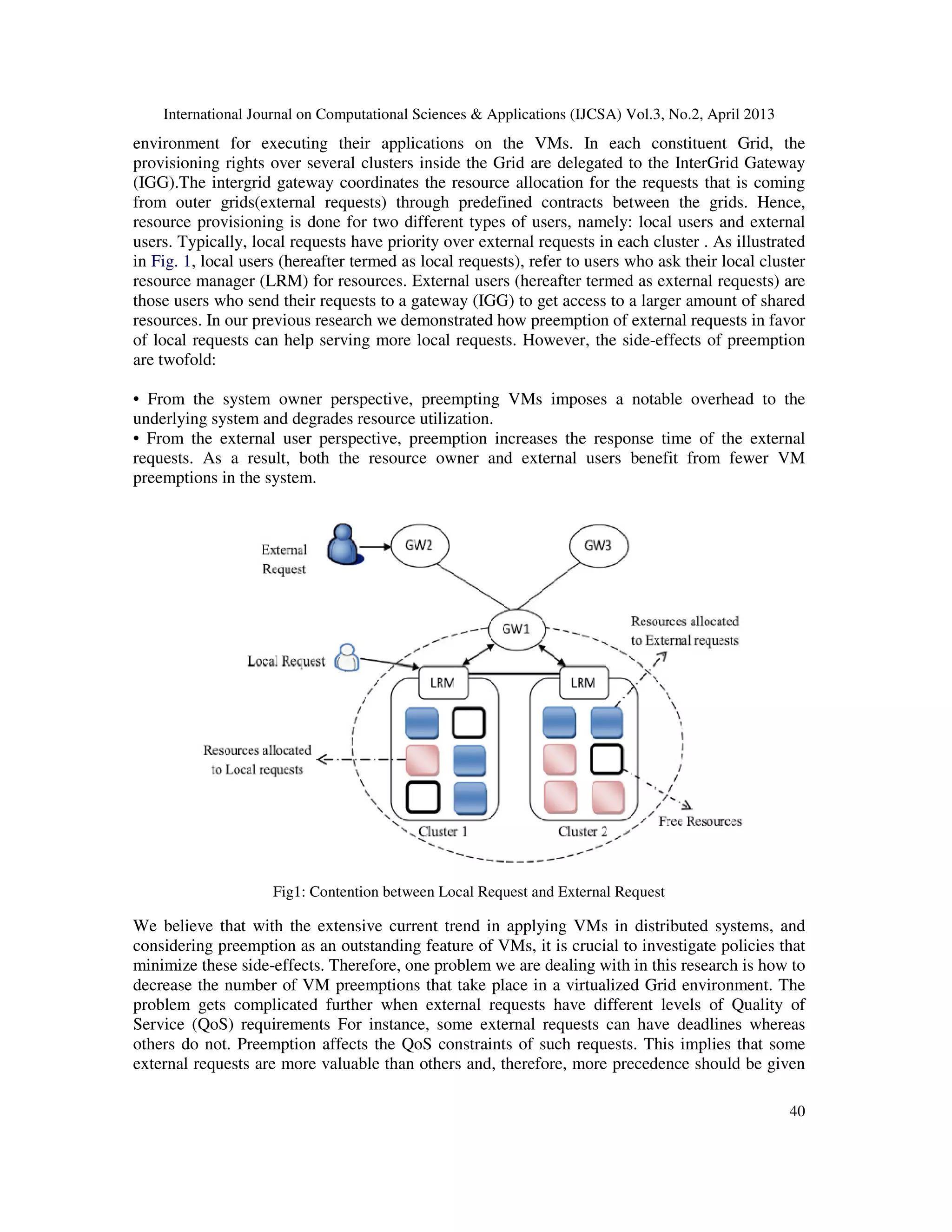
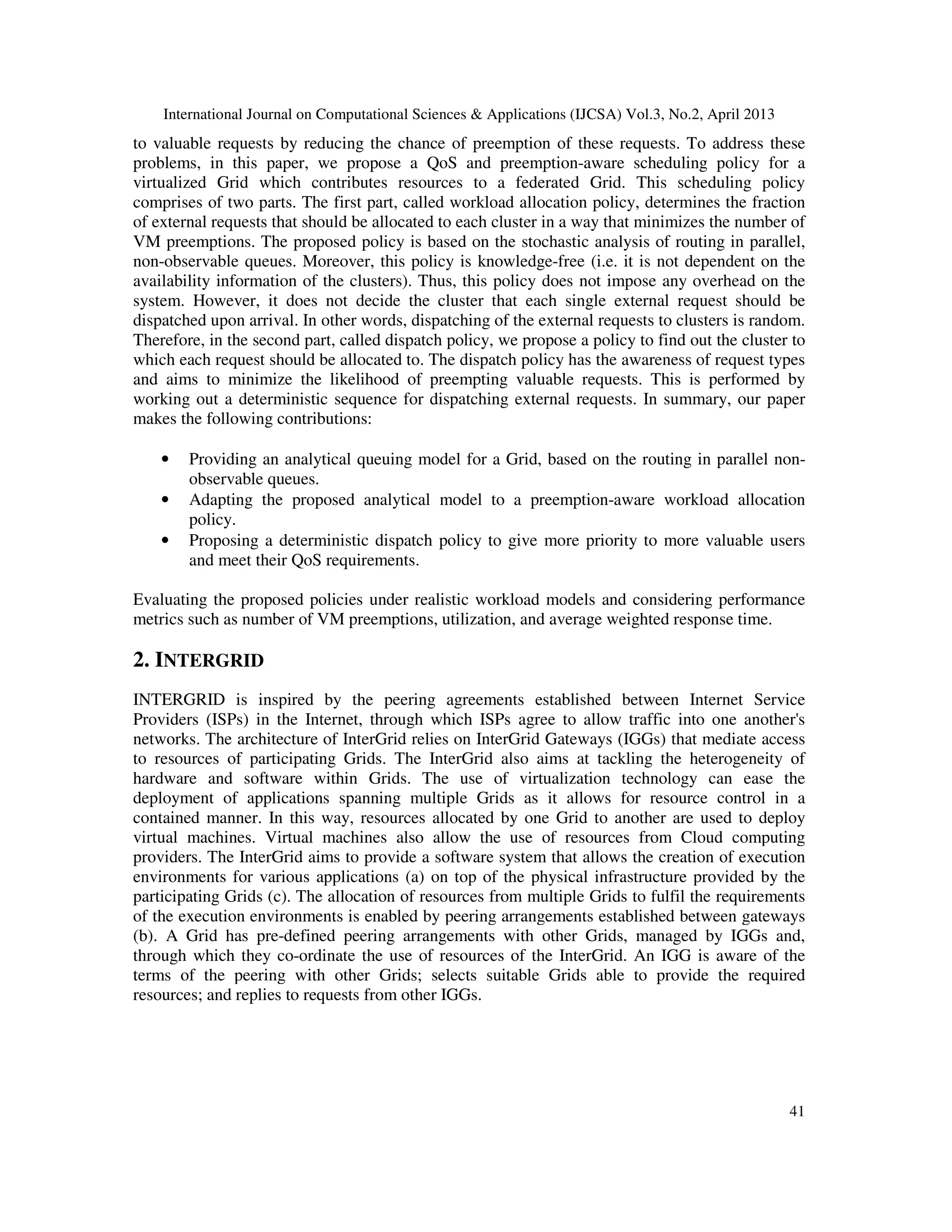
![International Journal on Computational Sciences & Applications (IJCSA) Vol.3, No.2, April 2013
42
Fig 2: Layers of intergrid
The Local Resource Manager (LRM)1 is the resource manager in each cluster which provisions
resources for local and external (Grid) requests. Resource provisioning in clusters of InterGrid is
based on the lease abstraction. A lease is an agreement between resource provider and resource
consumer whereby the provider agrees to allocate resources to the consumer according to the
lease terms presented by the consumer .Virtual Machine (VM) technology is used in InterGrid to
implement lease-based resource provisioning InterGrid creates one lease for each user request (in
this paper we apply these two terms interchangeably).
3. ANALYTICAL QUEING MODEL:
In this section, we describe the analytical modeling of preemption in a virtualized Grid
environment based on routing in parallel queues. This section is followed by our proposed
scheduling policy in IGG built upon the analytical model provided in this part. The queuing
model that represents a gateway along with several non-dedicated clusters (i.e. clusters with
shared resources between local and external requests) is depicted in Fig. 3. There are N clusters
where cluster j receives requests from two independent sources. One source is a stream of local
requests with arrival rate λj and the other source is a stream of external requests which are sent
by the gateway with arrival rate ˆΛj. The gateway receives external requests from other peer
gateways [12] (G1, . . . , Gpeer in Fig. 3). Therefore, external request arrival rate to the gateway is
Λ =  ̄Λ1 +  ̄Λ2 + ・・・+  ̄Λpeer where peer indicates the number of gateways that can
potentially send external requests to the gateway. Submitted local requests to cluster j must be
executed on cluster j unless the requested resources are occupied by another local request or a
Non-preemptive external request. The first and second moment of service time of local requests
in cluster j are τj and µj, respectively. On the other hand, an external request can be allocated to](https://image.slidesharecdn.com/5-130514010350-phpapp01/75/SCHEDULING-IN-GRID-TO-MINIMIZE-THE-IMPOSED-OVERHEAD-ON-THE-SYSTEM-AND-TO-INCREASE-THE-RESOURCE-UTILIZATION-4-2048.jpg)
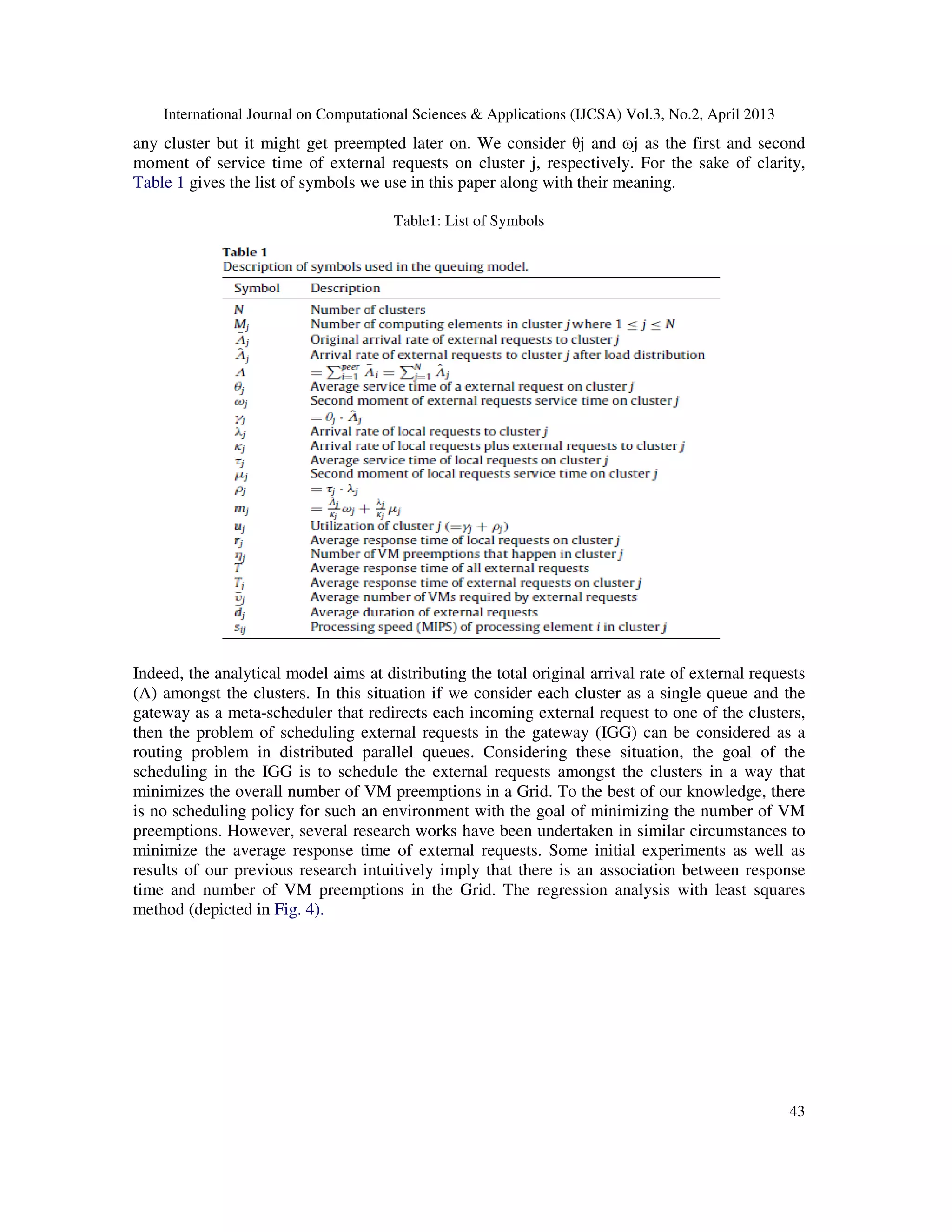
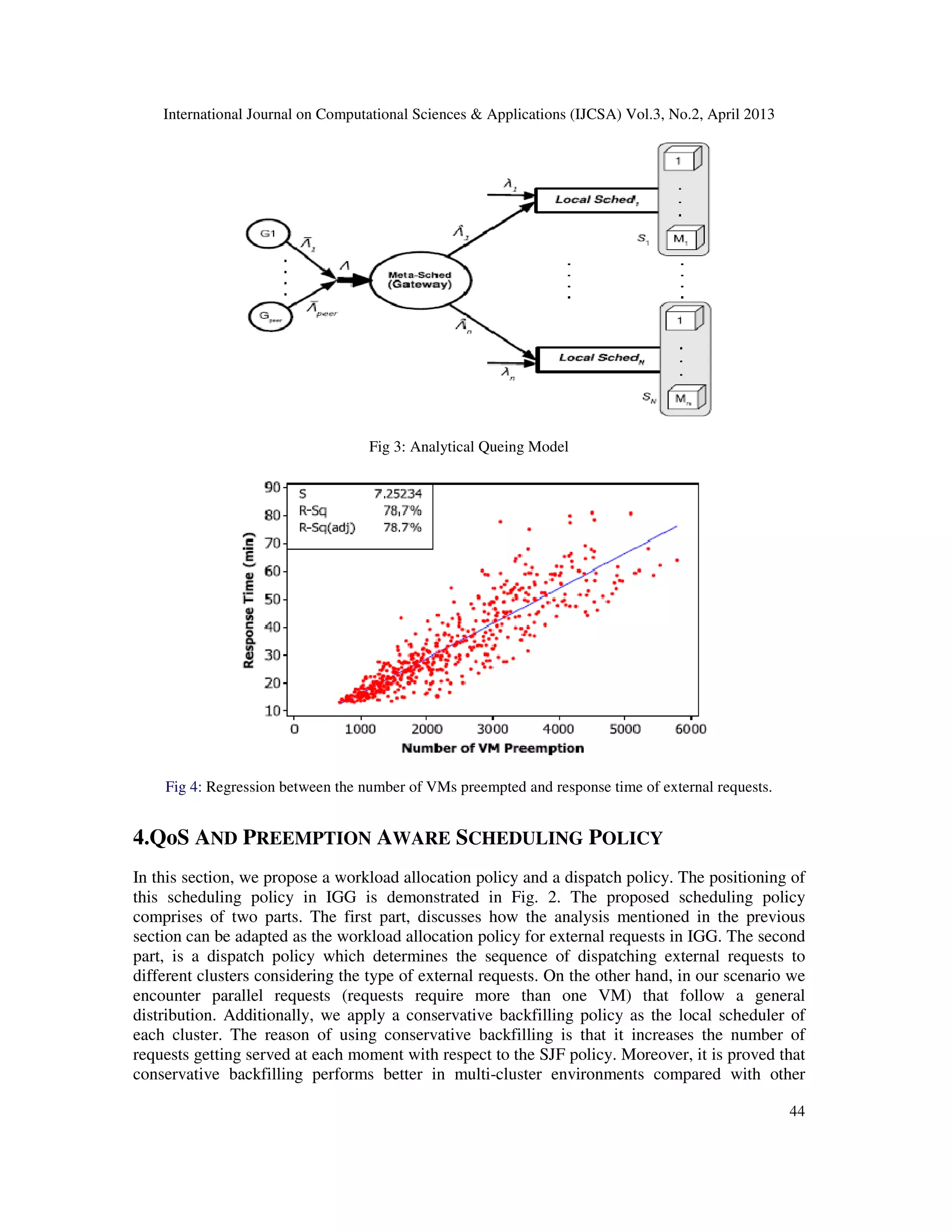
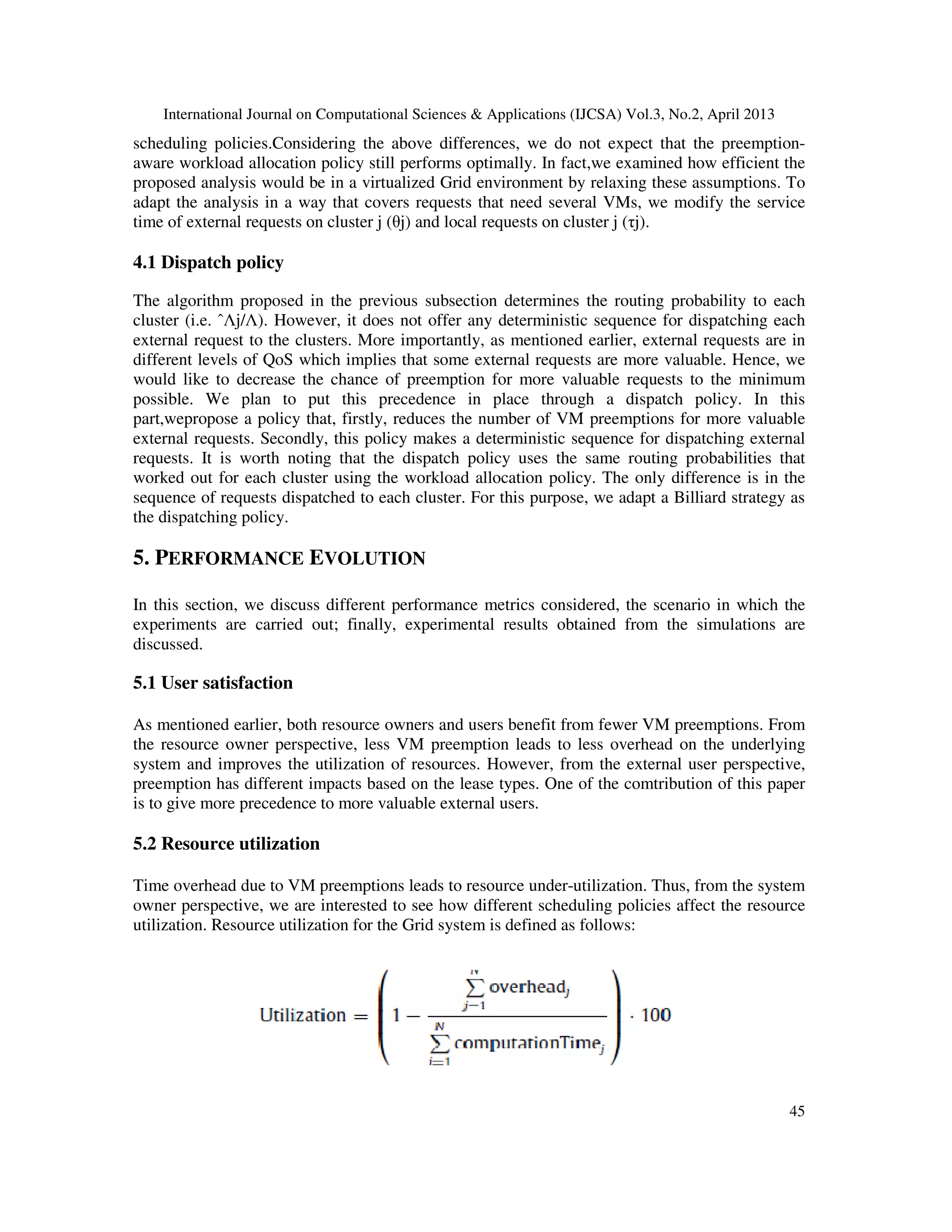
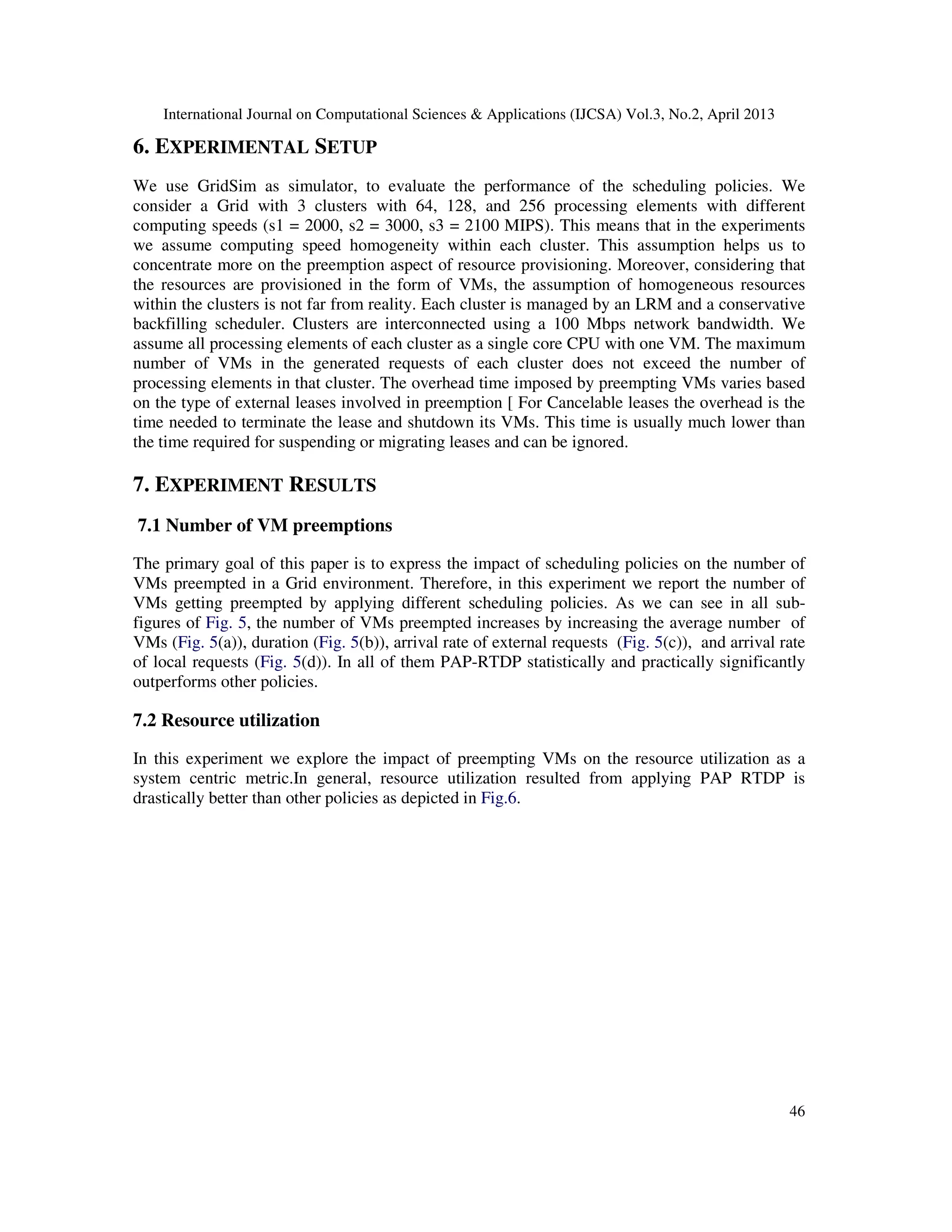

![International Journal on Computational Sciences & Applications (IJCSA) Vol.3, No.2, April 2013
48
8. RELATED WORKS
He et al. have aimed at minimizing response time and miss rate for non-real-time and soft real-
time jobs separately in the global scheduler of a multi-cluster by applying a non-observable
approach. They have also recognized workload allocation policy from job dispatching policy.
Nonetheless, for job dispatching they have applied policies such as weighted round robin policies.
By contrast, we consider a mixture of such jobs in our scenario which are affected by local
requests in each cluster.
Assuncao and Buyya have proposed policies in IGG based on adaptive partitioning of the
availability times between local and external requests in each cluster. Consequently, there is a
communication overhead between IGG and clusters for submitting availability information.
Bucur and Epema have evaluated the average response time of jobs in DAS-2 [25] by applying
local, global (external), and combination of these schedulers in the system. They have concluded
that the combination of local and global schedulers is the best choice in DAS-2.They have also
observed that it is better to give more priority to local jobs while the global jobs should also have
chance to run.
He et al. have proposed a multi-cluster scheduling policy where the global scheduler batches
incoming jobs and assigns each batch tuning to run the assigned jobs with minimized make span
and idle times.
Amar et al. have added preemption to cope with the non optimality of the on-line scheduling
policies. In the preemption policy jobs are prioritized based on their remaining time as well as the
job’s waiting cost. Schwiegelshohn and Yahyapour have investigated different variations of
preemptive first-come first- serve policy for an on-line scheduler that schedules parallel jobs
where the jobs’ run times and end times are unknown.
Margo et al. have leveraged a priority scheduling based on preempting jobs for Catalina to
increase the utilization of the resources. They determine the priority of each job based on the
expansion factor and number of processing elements each job needs.
9. CONCLUSIONS AND FUTURE WORK
In this research we explored how we can minimize the side effects of VM preemptions in a
federation of virtualized Grids such as InterGrid. We consider circumstances that local requests in
each cluster of a Grid coexist with external requests. Particularly, we consider situations that
external requests have different levels of QoS. For this purpose, we proposed a preemption-aware
workload allocation policy (PAP) in IGG to distribute external requests amongst different clusters
in a way that minimizes the overall number of VM preemptions that take place in a Grid.
Additionally, we investigated on a dispatch policy that regulates dispatching of different external
requests in a way that external requests with higher QoS requirements have less chance of getting
preempted. The proposed policies are knowledge-free and do not impose any communication
overhead to the underlying system.](https://image.slidesharecdn.com/5-130514010350-phpapp01/75/SCHEDULING-IN-GRID-TO-MINIMIZE-THE-IMPOSED-OVERHEAD-ON-THE-SYSTEM-AND-TO-INCREASE-THE-RESOURCE-UTILIZATION-10-2048.jpg)
![International Journal on Computational Sciences & Applications (IJCSA) Vol.3, No.2, April 2013
49
References
[1] L. Amar, A. Mu’Alem, J. Stober, The power of preemption in economic online markets, in:
Proceedings of the 5th International Workshop on Grid Economics and Business Models,
GECON’08, Springer-Verlag, Berlin, Heidelberg, 2008, pp. 41–57.
[2] J. Anselmi, B. Gaujal, Optimal routing in parallel, non-observable queues and the price of anarchy
revisited, in: 22nd International Teletraffic Congress, ITC, Amsterdam, The Netherlands, 2010, pp.
1–8.
[3] N.T. Argon, L. Ding, K.D. Glazebrook, S. Ziya, Dynamic routing of customers with general delay
costs in a multiserver queuing system, Probability in theEngineering and Informational Sciences 23
(2) (2009) 175–203.
[4] F. Bonomi, A. Kumar, Adaptive optimal load balancing in a non homogeneous multiserver system
with a central job scheduler, IEEE Transactions on Computers 39 (1990) 1232–1250.
[5] A. Bucur, D. Epema, Priorities among multiple queues for processor co allocation in multicluster
systems, in: Proceedings of the 36th Annual Symposium on Simulation, IEEE Computer Society,
2003, pp. 15–22.
[6] J.S. Chase, D.E. Irwin, L.E. Grit, J.D. Moore, S.E. Sprenkle, Dynamic virtual clusters in a Grid site
manager, in: Proceedings of the 12th IEEE International Symposium on High Performance
Distributed Computing, Washington, DC, USA, 2003, pp. 90–98.
[7] P. Chen, J. Chang, T. Liang, C. Shieh, A progressive multi-layer resource reconfiguration framework
for time-shared Grid systems, Future Generation Computer Systems 25 (6) (2009) 662–673.
[8] B. Chun, D. Culler, T. Roscoe, A. Bavier, L. Peterson, M. Wawrzoniak, M. Bowman, PlanetLab: an
overlay testbed for broad-coverage services, ACM SIGCOMM Computer Communication Review 33
(3) (2003) 3–12.
[9] M. Colajanni, P. Yu, V. Cardellini, Dynamic load balancing in geographically distributed
heterogeneous web servers, in: Proceedings 18th International Conference on Distributed Computing
Systems, 1998, IEEE, 2002, pp. 295–302.
[10] M.D. De Assunção, R. Buyya, Performance analysis of multiple site resource provisioning: effects of
the precision of availability information, in: Proceedings of the 15th International Conference on High
Performance Computing, HiPC’08, Springer-Verlag, Berlin, Heidelberg, 2008, pp. 157–168.
[11] M. De Assunção, R. Buyya, S. Venugopal, InterGrid: a case for internetworking islands of Grids,
Concurrency and Computation: Practice and Experience 20 (8) (2008) 997–1024.
[12] A. di Costanzo, M.D. de Assuncao, R. Buyya, Harnessing cloud technologies for a virtualized
distributed computing infrastructure, IEEE Internet Computing 13 (2009) 24–33.
doi:10.1109/MIC.2009.108.
[13] J. Fontán, T. Vázquez, L. Gonzalez, R.S. Montero, I.M. Llorente, OpenNebula: the open source
virtual machine manager for cluster computing, in: Open Source Grid and Cluster Software
Conference—Book of Abstracts, San Francisco, USA, 2008.
[14] L. Gong, X.-H. Sun, E.F. Watson, Performance modeling and prediction of nondedicated network
computing, IEEE Transactions on Computers 51 (2002) 1041–1055.
[15] C. Grimme, J. Lepping, A. Papaspyrou, Prospects of collaboration between compute providers by
means of job interchange, in: Job Scheduling Strategiesfor Parallel Processing, Springer, 2008, pp.
132–151.
[16] L. He, S. Jarvis, D. Spooner, X. Chen, G. Nudd, Dynamic scheduling of parallel jobs with QoS
demands in multiclusters and Grids, in: Proceedings of the 5th IEEE/ACM International Workshop on
Grid Computing, IEEE Computer Society, 2004, pp. 402–409.](https://image.slidesharecdn.com/5-130514010350-phpapp01/75/SCHEDULING-IN-GRID-TO-MINIMIZE-THE-IMPOSED-OVERHEAD-ON-THE-SYSTEM-AND-TO-INCREASE-THE-RESOURCE-UTILIZATION-11-2048.jpg)